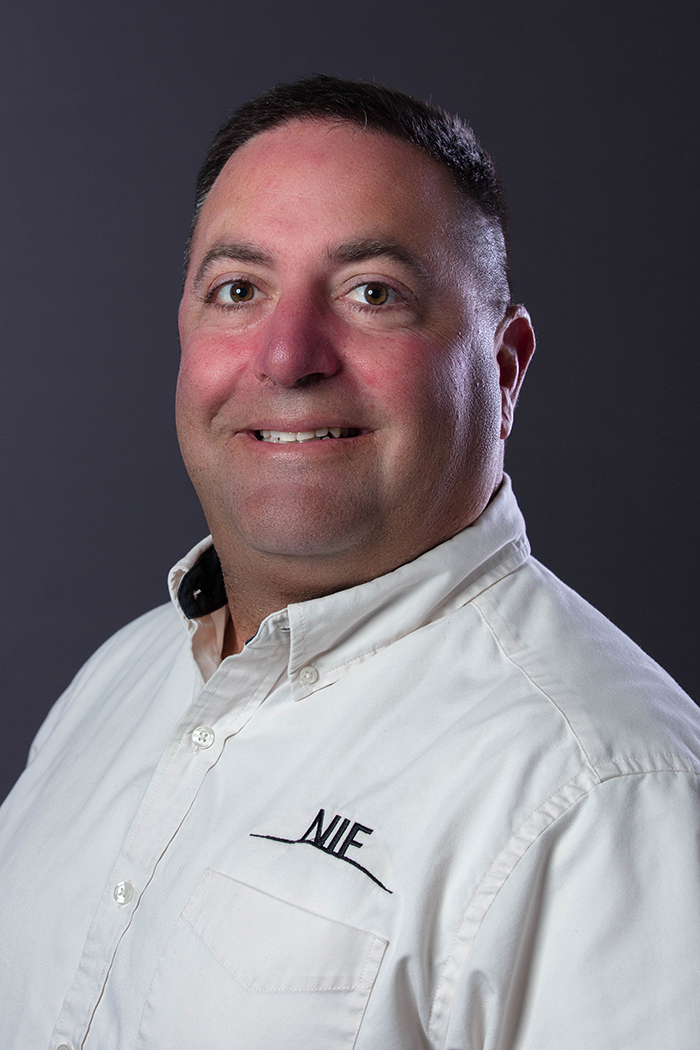Meet the People Behind the Scenes of
LLNL’s Historic Ignition Shot
August 2, 2023
Part 12 of “The Age of Ignition,” a NIF & Photon Science News Special Report describing the elements of Lawrence Livermore National Laboratory’s fusion breakthrough at the National Ignition Facility

When Lawrence Livermore National Laboratory (LLNL) blasted its way into history by reaching fusion ignition on Dec. 5, 2022, the milestone marked the culmination of more than 60 years of accomplishments since the advent of lasers. The achievement came thanks to the efforts of thousands of scientists, engineers, technicians, and others in the worldwide inertial confinement fusion and high energy density community.
The essential contributors to those efforts also included hundreds of Lab employees who work diligently behind the scenes and often out of public view.
“The NIF Operations teams in the Target Bay and Control Room did an incredible job working meticulously through the long preparation to get the laser, diagnostic systems and the DT (deuterium-tritium) fuel layered target ready for the Control Room to start the shot sequence,” said Bruno Von Wonterghem, NIF’s longtime commissioning and operations manager. “The team worked diligently through all issues and successfully fired all 192 beams with all systems participating.
“The best reward was that they were the first people to know that this shot was very different, as the alarms started sounding,” Von Wonterghem said. “They made history happen.”
Here are profiles of just a few of the key workers who played a crucial role in the groundbreaking experiment—and who will continue to perform essential duties at the Lab:
Stephen Moyle, Hazardous Material Management Area (HMMA) Manager,
Radioactive Waste Manager
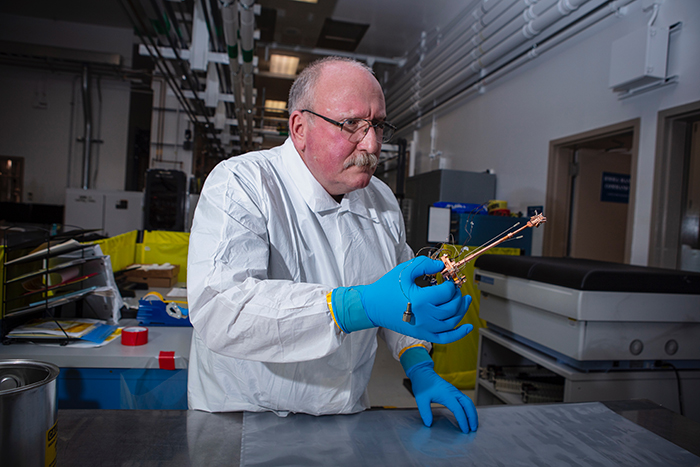 Stephen Moyle, Hazardous Material Management Area (HHMA) manager and NIF radioactive waste manager, is “handling history” by holding the target stalk used in the Dec. 5 experiment that produced fusion ignition at LLNL. Credit: Jason Laurea
Stephen Moyle, Hazardous Material Management Area (HHMA) manager and NIF radioactive waste manager, is “handling history” by holding the target stalk used in the Dec. 5 experiment that produced fusion ignition at LLNL. Credit: Jason Laurea Job responsibilities: “I’m responsible for the safe and compliant management of the volumes of radioactive waste generated at NIF, which is the largest generator of such waste at the Lab. Although there are certainly more important and flashy jobs at NIF, I’m proud of what I do.
“With the help of Tim Fuller, my indispensable and dedicated Radioactive and Hazardous Waste Management (RHWM) technician, and our partners at RHWM, we have been able to manage this vast amount of waste for 12-plus years safely, without incident. This also speaks volumes about the entire workforce at NIF. We could not be as successful with waste management without our professional workforce who know the importance of properly handling radioactive waste. It’s a great pleasure to work with them daily.
“Another important aspect of my job is waste minimization. Over the years, the policies and procedures I have put in place have led to NIF greatly reducing its amount of waste generated even with an increased shot schedule.
“If you think of this target stalk as the first flight of fusion energy, where will we be in 25 years?”
—Hazardous Material Management Area Manager Stephen Moyle
“As HMMA manager, I supervise a user facility that various work groups use to work on diagnostics as well as any other contaminated equipment. I also have the equipment, procedures, and experience to decontaminate any items that are required to be transferred to any facility which is not authorized to handle radioactive material, on site or off.”
Career and background at the Lab: “I spent 20 years in the U.S. Navy operating nuclear power plants on submarines. I always knew I would work at the Lab because both of my parents retired from here and my former high school girlfriend and current wife has worked here for 30-plus years. I started working at the Lab in 2005 with a short stint as a health and safety technician and was promoted to safety officer for the Physical and Life Sciences (PLS) Directorate in 2007. Started at NIF in 2009; have been here ever since. Greatest job at NIF.”
Role in the Dec. 5 shot: “My role in the historic shot came after the shot was completed. I was asked to decontaminate the actual target stalk that held the target for the first fusion shot ever! It’s a very humbling job; I’m handling history. I get to make this historic item safe for the public to view and enjoy in whatever venue it ends up in.”
Reaction to the fusion ignition milestone: “As I’m working on this target stalk in the HMMA, I think of direct parallels to the Wright brothers flight (in 1903).
“The Wright brothers first flight took less than a minute and was less than 1,000 feet in length, but it was the first time in history it had ever been accomplished. Moreover, there were a lot of smart people at the time that said it would never happen.
“Within 25 years of the Wright brothers first flight, Charles Lindbergh was flying across the entire Atlantic Ocean all by himself. What a difference 25 years makes in the history of aviation.
“If you think of this target stalk as the first flight of fusion energy, where will we be in 25 years? I find it very cool and exciting to think about what the fusion energy equivalent of Lindbergh’s flight is going to look like not that far in the future. The possibilities are limitless and it’s a very exciting and rewarding time to work at NIF.”
Jessica Vaher, Engineering Technical Associate and Team Lead for Control System Electronics Technologists (E-Techs)
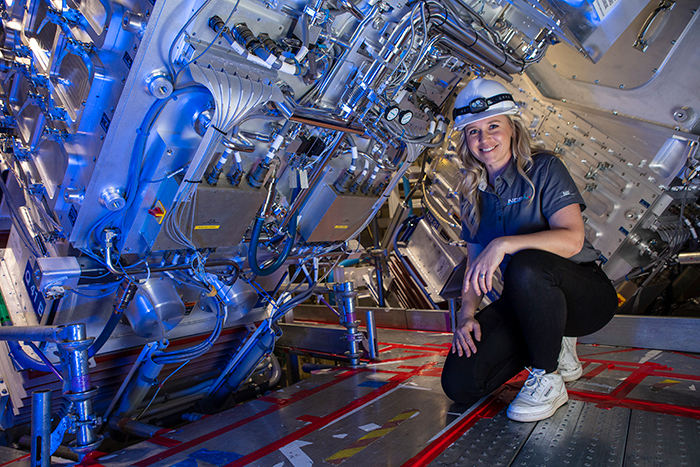 Jessica Vaher works with the NIF control system electronics technologists (E-Techs) to maintain the NIF control system and support shot operations. Credit: Jason Laurea
Jessica Vaher works with the NIF control system electronics technologists (E-Techs) to maintain the NIF control system and support shot operations. Credit: Jason Laurea Job responsibilities: “My responsibilities include scheduling and coordinating E-Tech resources to perform controls hardware reactive/preventative maintenance tasks, configure new hardware for upgrades, and test controls as additional laser and diagnostic systems are commissioned. In parallel, as a senior E-Tech and part of the on-call controls hardware team, I work with the E-Techs to maintain the NIF control system and support shot operations 24/7. This involves testing, troubleshooting, and replacing controls hardware for the Integrated Computer Control System (ICCS), the Industrial Control System (ICS), and the Safety Interlock System (SIS).”
Career and background at the Lab: Vaher earned her B.S. in computer engineering technology from DeVry University and began her career at LLNL in 2005. She has worked in Lasers Systems Engineering and Operations (LSEO) at NIF for 18 years.
From 2005 to 2006, in the NIF controls hardware group as an E-Tech, she built, configured, calibrated, and tested the front end processors for alignment control, wavefront control, laser energy, timing, and diagnostic video.
“When I joined NIF in 2005, I knew this was a unique facility with impressive goals. I was excited to contribute and be part of a project found nowhere else on Earth.”
—Engineering Technical Associate Jessica Vaher
From 2006 to 2014, in the NIF control room as a duty engineer for shot operations, she monitored and maintained the processes running within ICCS, executed software deployment plans, queried and updated the ICCS database, and analyzed software issues while gathering data for developers.
From 2014 to 2015, as a target area coordinator for shot operations, she aligned high-precision diagnostics and targets within the Target Chamber, documented component issues and inconsistencies, and operated ICS to pump and vent vessels in support of diagnostic and target exchanges.
She became an electronics technologist in 2015 and senior electronics technologist in 2019. She became E-Techs team lead the following year and added her current role as engineering technical associate in 2021.
Role in the Dec. 5 shot: “In the week leading up to the Dec. 5 shot, I worked with my team to resolve outstanding control system issues to help ensure that the laser and diagnostics systems on all 192 beamlines would be available for the experiment. In the hours leading up to the system shot, I was standing by as part of the controls hardware on-call team to support shot operations and resolve any potential control system issues during the shot cycle.”
Reaction to the ignition milestone: “When I joined NIF in 2005, I knew this was a unique facility with impressive goals. I was excited to contribute and be part of a project found nowhere else on Earth. In conversations with friends outside of work over the years, the topic of moving inevitably comes up and when asked if I’d ever move out of California, I respond with, ‘But there’s no NIF!’
“I remember working in the Control Room on Owl shift when we were taking system shots on the first commissioned bundle (of laser beams), Bundle 31. I remember when we were still counting and increasing the number of commissioned line replaceable units (LRUs), which were represented by a growing stack of wooden blocks in the strategy room. With the achievement of fusion ignition, we’ve come so far since those first system shots on just one bundle, and NIF still has untapped potential. I can’t wait to see what challenges we overcome next.”
Kelsey Wilson, Laser, Engineering, and Optics Technician on the Beam Control/Target Area Alignment Team
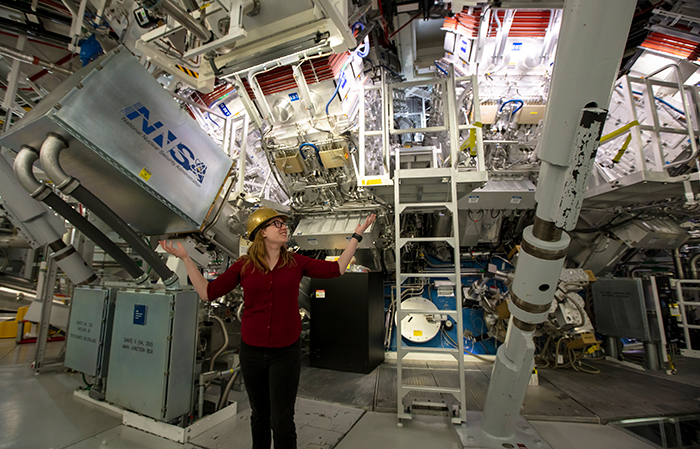 Kelsey Wilson helps align the target inside the Target Chamber. Credit: Jason Laurea
Kelsey Wilson helps align the target inside the Target Chamber. Credit: Jason Laurea Job responsibilities and role in the Dec. 5 shot: “As an alignment operator on these teams, we’re in charge of aligning the target inside the Target Chamber to within a few microns and making sure that all 192 NIF beams are going to land correctly on the target, as well as making sure that all of the diagnostics that the scientists need for the shot are aligned so they actually collect all the data they need for each shot.”
“The first time humanity created ignition? Yeah, I was totally there. I helped do that.”
—Alignment Operator Kelsey Wilson
Career and background at the Lab: “I’ve been at NIF on the alignment teams for two-and-a-half years now. Before that, I was working as a quality assurance inspector at a company that makes the aluminum parts for companies like Alcon and Newport while I was finishing my laser technology and electronics technology degrees at Irvine Valley College and Pasadena City College.
Reaction to the fusion ignition milestone: “As far as the shot goes, it’s so cool to know that I’ll be able to look back on this in the future and be able to say, ‘Oh yeah, the first time humanity created ignition? Yeah, I was totally there. I helped do that.’
Wilson is part of the behind-the-scenes team that helps make the NIF magic happen.
“We’re a 24/7 facility, we work 13-hour days to be able to do the science that we do. We’re always up here working away, doing our thing.”
Matt Cohen, Deputy Section Leader for Target Experimental Operations (TEXOPS)
Job responsibilities and role in the Dec. 5 shot: Cohen assisted in the planning and execution of the setup and recovery of diagnostics before and after the shot.
Career and background at the Lab: Cohen served as an electronics technician and nuclear reactor operator in the U.S. Navy Submarine Service from 1996 to 2002. He began at the Lab and at NIF in 2004 as an instrument calibration technician. He spent several years helping to commission NIF utility systems before becoming a work center supervisor and eventually moving to his current role.
Reaction to the fusion ignition milestone: “I feel extremely lucky to be part of this NIF team. It’s humbling to think about how many people’s entire careers were devoted to get us to this milestone. I’m looking forward to the challenge of what’s in store over the next decade and hope I can contribute to future successes.”
Daren Hart, Shot Operations Lead Operator
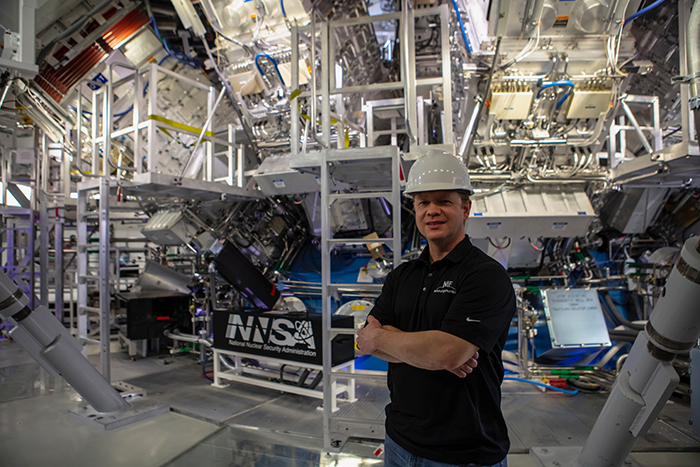 Daren Hart, lead operator for NIF shot operations, fondly remembers his many colleagues who contributed to the ignition achievement. Credit: Jason Laurea
Daren Hart, lead operator for NIF shot operations, fondly remembers his many colleagues who contributed to the ignition achievement. Credit: Jason Laurea Job responsibilities: Hart is responsible for the coordination and management of all NIF operations and supporting staff.
Background and career at the Lab: Hart’s NIF roles have included serving as alignment operator from 2006 to 2015, Target Area coordinator from 2015 to 2017, and lead operator from 2017 to the present.
Role in the Dec. 5 shot: “In support of the shot that resulted in the ignition milestone, I coordinated facility preparations, executed preliminary laser performance checks, and verified that all experiment prerequisites were completed.”
Reaction to the fusion ignition milestone: “Achieving ignition has brought on a bit of nostalgia for me.
“I remember the excitement when I started working here in the commissioning phase of NIF. Many times, conversations would focus on the anticipation of ignition. Some wanted to see the black hole it made. Others couldn't wait to find out what superpower they got. So on and so forth. The essence of those jokes was that people wanted to be there when it happened.
“Most of all, the accomplishment reminds me of the many people I have worked with here over the years. Several NIF veterans continue going strong and a few of the legends are still around. But many faces have come and gone for a multitude of reasons. Thankfully, the new generations that fill those voids always bring new perspective and fresh ideas to further advance the project.
“There are times that a topic will come up and I will remember a face and situation, but the names occasionally elude me. I wish we had a NIF yearbook, mostly to acknowledge all the people that have contributed toward the ignition milestone.
“Overall, I take pride in knowing that I played my part in the historical achievement.”
Jaclyn Guzman, Industrial Controls Team, Engineering Technologist and Facility Infrastructure Maintenance Technician
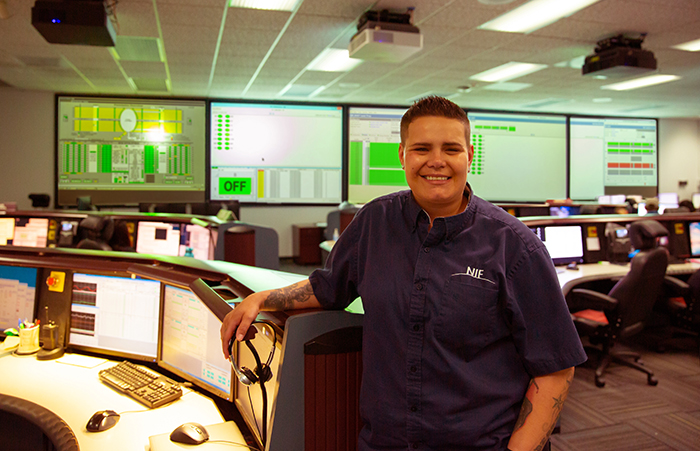 Jaclyn Guzman is a multi-system operator, responsible for the operation and maintenance of a wide variety of auxiliary shot support systems. Credit: Mark Meamber
Jaclyn Guzman is a multi-system operator, responsible for the operation and maintenance of a wide variety of auxiliary shot support systems. Credit: Mark Meamber Job responsibilities: Guzman is a multi-system operator, responsible for the operation and maintenance of a wide variety of auxiliary systems, including Vacuum, Argon, HVAC, System Cooling, Tritium Processing, and other systems during and outside of the shot cycle.
“This is world history at its finest, working with some of the most brilliant and inspiring people from around the world.”
—Engineering Technologist Jaclyn Guzman
Career and background at the Lab: Guzman spent eight years in the U.S. Army Military Police Corps Protective Services Battalion assigned to high-value targets. She has always had an interest in nuclear advancements and, after obtaining her degree in engineering technology, she joined the NIF team two years ago and “love(s) every second of it.”
Role in the Dec. 5 shot: Guzman was focused on making sure all auxiliary shot support systems were operating effectively enough to ensure smooth execution of the high-yield shot.
Reaction to the fusion ignition milestone: “I feel honored to be a part of such a tremendous scientific breakthrough. This is world history at its finest, working with some of the most brilliant and inspiring people from around the world. I look forward to witnessing how the insight and understanding we have gleaned from this momentous experiment will help us usher in a new era of energy technology.”
Shannon Sauers, Radiation Safety Officer
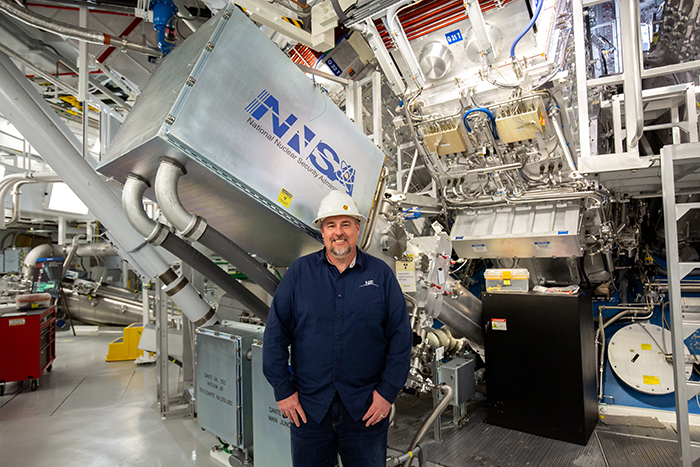 Shannon Sauers, NIF radiation safety officer, has seen NIF achieve “many important milestones.” Credit: Mark Meamber Job responsibilities and role in the Dec. 5 shot: Before the shot, Sauers was responsible for planning post-shot diagnostic recovery to maximize efficiency and maintain worker doses at ALARA (As Low as Reasonably Achievable) levels in anticipation of high yield.
Shannon Sauers, NIF radiation safety officer, has seen NIF achieve “many important milestones.” Credit: Mark Meamber Job responsibilities and role in the Dec. 5 shot: Before the shot, Sauers was responsible for planning post-shot diagnostic recovery to maximize efficiency and maintain worker doses at ALARA (As Low as Reasonably Achievable) levels in anticipation of high yield. After the shot, his duties included radiological control oversight of the NIF Target Bay reentry and recovery of diagnostics, utilizing high-radiation-area controls.
He also calculated expected dose rates of diagnostics based on yield and typical half-life, and worked with Operations to arrange the recovery schedule based on when individual diagnostics would meet radiological work permit limits. In addition, he managed individual worker doses, ensuring that recovery exposure limits were not exceeded.“Being a part of the journey and seeing all the hard work come to fruition is extremely gratifying.”
—Radiation Safety Officer Shannon Sauers
Career and background at the Lab: “I’ve worked in radiological control for 18 years. Have been at LLNL for 12 years, all at NIF. Prior to LLNL, I worked at the Nevada Test Site and the Hanford Site.”
Reaction to the fusion ignition milestone: “Based on Target Bay dose rates (from neutron activation) immediately following the shot, we knew we had likely achieved a record yield. There was immediate excitement in the facility and high expectations as we waited for the official yield number. I’ve been at NIF long enough to see many important milestones, including producing the first detectable neutrons, and now through ignition. Being a part of the journey and seeing all the hard work come to fruition is extremely gratifying.”
Priscilla Yung, Industrial Hygienist
Job responsibilities and role in the Dec. 5 shot: “As a certified industrial hygienist and safety professional, I provide primary industrial hygiene oversight to the NIF as part of a multi-disciplinary Integrated Safety Team.
“My job is to ensure that NIF personnel do not get exposed to hazardous substances during the course of their work so they can focus on the cutting-edge science and innovation that is needed to make the world a safer place through its stockpile stewardship mission and unlimited sustainable energy mission.
“My job entails a weekly review of all the constituents that comprise the targets scheduled to be shot the following week, including the target used in the historic Dec. 5 shot, to ensure that any potential contamination that may be produced and subsequently expose workers during Target Chamber entry, diagnostic handling, and maintenance/repair/configuration activities are within acceptable limits and properly controlled to prevent overexposures.
“Among other duties, I also ensure that proper safe entry procedures are followed when entering the NIF beampath, where physical hazards such as lasers and atmospheric hazards such as oxygen-displacing inert gases are present.”
Career and background at the Lab: “I joined the Lab seven years ago, first supporting Operations & Business, then Physical and Life Sciences, and for the past two years, NIF & Photon Science.”
Reaction to fusion ignition milestone: “When I heard the news about ignition, on CNN of all places, I was on a vacation with my family. My first reaction was one of surprise, followed by gratitude. Gratitude for the fact that I got to play a small, but nonetheless important, role in such a historic, world-changing event. Gratitude for my team, which included two colleagues—Anni Mai and Sam Paik—who provided seamless backup for me while I was away on a vacation. And gratitude for the privilege of helping improve the world that my daughter will be inheriting, one full of hope and endless possibilities.”
Miguel Castro, Integrated Safety Team Leader
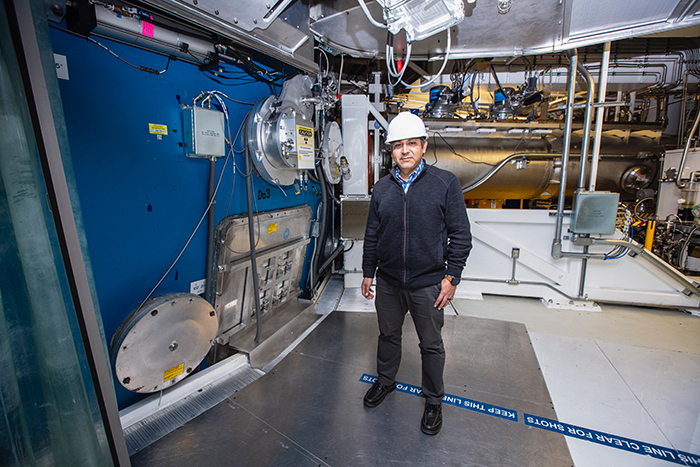 Miguel Castro, NIF&PS integrated safety team leader, stands in front of the N41 direct drive port, where the Lab previously deployed metal coupons to indirectly characterize the induced radioactivity of all metallic equipment in the Target Bay. This methodology was briefly used at NIF before higher yields forced the Lab to abandon it. Credit: Jason Laurea
Miguel Castro, NIF&PS integrated safety team leader, stands in front of the N41 direct drive port, where the Lab previously deployed metal coupons to indirectly characterize the induced radioactivity of all metallic equipment in the Target Bay. This methodology was briefly used at NIF before higher yields forced the Lab to abandon it. Credit: Jason Laurea Job responsibilities and role in the Dec. 5 shot: “I work with programmatic personnel to identify and manage risks associated with mission work. My role on Dec. 5 was limited. Most of the analysis and decision-making had already been completed in anticipation of the results.”
Career and background at the Lab: “I have worked at LLNL for almost 21 years. I began my career as a Health & Safety tech. The Lab helped me by paying for my graduate study in health physics and I filled that role for a decade with half of that time served at NIF. In 2019, I went into Environment, Safety, & Health management.
Reaction to the fusion ignition milestone: “I realize my role is small in this big achievement, but it reminds me of a story from NASA where President John F. Kennedy asks a janitor what he does (for the agency) and he responds that he is helping put a man on the moon. That sentiment echoes in my mind because I believe that paramount to this achievement was the commitment from many different individuals to contribute as best they can to a common goal.”
Alexander Yang, Health Physicist
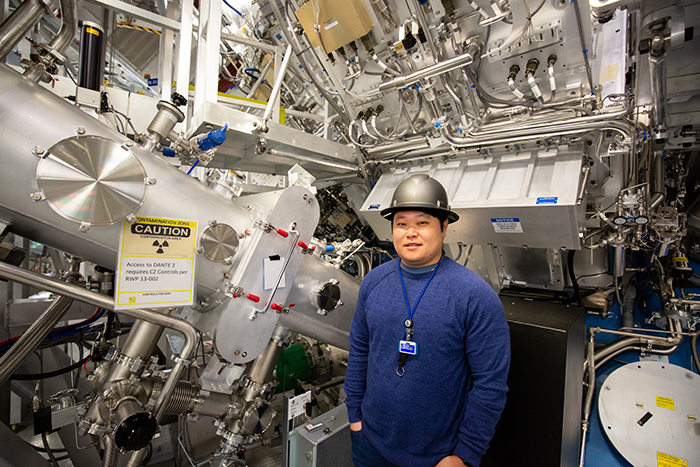 Alexander Yang, NIF&PS health physicist, and his team worked on anticipating and preparing for hazardous radiological conditions in the Target Bay to ensure safe working conditions. Credit: Jason Laurea
Alexander Yang, NIF&PS health physicist, and his team worked on anticipating and preparing for hazardous radiological conditions in the Target Bay to ensure safe working conditions. Credit: Jason Laurea Job responsibilities: As the health physicist, Yang anticipates, identifies, and evaluates radiological hazardous conditions resulting from program activities. He develops and implements policies, procedures, and standards to ensure those hazards are managed to ensure proper and safe working conditions.
“It’s incredibly exciting to be working for an organization that is pushing the boundaries of science every day.”
—Health Physicist Alexander Yang
Career and background at the Lab: Yang has worked for seven years as a health physicist and has been at the Lab for two years. Before arriving at LLNL, he worked five years at Pearl Harbor Naval Shipyard in Honolulu, Hawaii, in dosimetry, environmental monitoring, and as a radiation safety officer.
Role in the Dec. 5 shot: “Most of our team’s responsibility for the Dec. 5 milestone was in preparation and anticipation of the conditions in the Target Bay. Following a high-yield experiment at NIF, the Target Bay becomes heavily activated by the neutrons produced. My team and I worked to develop a robust radiological control program to manage exposure from ionizing radiation to the radiological workers who must enter the Target Bay to begin recovery operations.”
Reaction to the fusion ignition milestone: “It’s incredibly exciting to be working for an organization that is pushing the boundaries of science every day. The ignition shot on Dec. 5 puts a lot of what we do into perspective and I’m thankful I was able to be a part of it. I think people were proud to work at NIF before, but after the ignition milestone, spirits are especially high now. I haven’t seen people, not just my team, this excited about anything since I’ve been at the Lab.”
More Information:
“The Age of Ignition: A NIF & Photon Science News Special Report”
“How AI Predicted Fusion Ignition Before It Happened,” LLNL Data Science Institute Seminar, February 15, 2023
“Deep Learning Surrogate Models Could Hasten New Scientific Discoveries,” NIF & Photon Science News, June 25, 2020
“World’s Largest Computer Chip Opens New AI Doors for NIF,” NIF & Photon Science News, September 3, 2020
—Jon Kawamoto
Follow us on Twitter: @lasers_llnl
